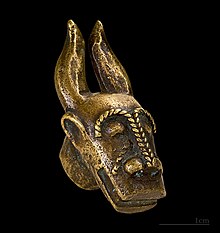User:Ciaolee/Akan goldweights/Bibliography
Bibliography[edit]
- Konadu, K. (2010). The Akan Diaspora in the Americas. Oxford University Press.[1]
- This is a book published by a university press and covers more of the trading culture behind the Akan goldweights and the spread of them across Africa. Not mentioned in the Wiki article but in the book is the cultural distinction of the figural and goldweights from West Africa and the geometric weights from North Africa (Konadu, 2010, p.52)
- Hewson, A.D. (n.d.) The Ashanti Weights A Statistical Evaluation. Journal of Archeological Science.[2]
- This is a peer reviewed paper from a credible journal and details the measuring system aspect of the goldweights. The Wiki article mentions the differences in figurative and geometric goldweights however this paper expands on the intentional integer multiples of geometric weights while figural goldweights have little mappable quantization. (Hewson, p.369)
- Kouadio A.Y. (2018) Akan Gold weights: Values perspectives of a non-western cultural artifact. University of California.[3]
- this is a peer reviewed paper from a university press and details how these goldweights are treated in museums. this quote from page 27 sums up part of the authors argument. "While the museum as an institution represents by default the window of the world through its cabinet of curiosity, it is also a ritual space for the performance of colonial power and politics." (Kouadio, 2018, p.27)
- Wistar, C. (2000) Akan Goldweights: Masterpieces in Miniature. La Salle University Art Museum.[4]
- This journal goes over the gold standard of west africa and how Akan goldweights factor into trade on the gold coast. In particular the author describes the uniqueness of this form of African art in it's utilitarian aspects. The article suggests that much of African art is ritualistic and/or ceremonial whereas these goldweights give us a better look into the day to day life of west African villages. (Wistar, 2000, p.8)
- Ross, D.H. (1981) The Heraldic Lion in Akan Art: A Study of Motif Assimilation in Southern Ghana. The University of Chicago Press on behalf of The Metropolitan Museum of Art.[5]
- This article dives into the imagery of lions in west African art and culture and the prominence of leopards over lions in Akan goldweights. While the animal is indigenous, the motif in west african art is not and seems to have been inspired and implemented from European heraldry. The paper covers many examples of European influence of depictions of lions such as on shields, coat of arms, and mastheads of ships. from page 174, "The lion in different heraldic postures was a corporate emblem of many West African trading companies and especially of nineteenth-century British firms." (Ross, 1981, p.174)
Edit this section to compile the bibliography for your Wikipedia assignment. Add the name and/or notes about what each source covers, then use the "Cite" button to generate the citation for that source.
Examples:
|
References[edit]
- ^ Konadu, Kwasi (2010-05-12). The Akan Diaspora in the Americas. Oxford University Press, USA. ISBN 978-0-19-539064-3.
- ^ "ScienceDirect.com | Science, health and medical journals, full text articles and books". www.sciencedirect.com. Retrieved 2024-02-18.
- ^ "Akan Gold Weights: Values Perspectives of a Non-western Cultural Artifact - ProQuest". www.proquest.com. Retrieved 2024-02-18.
- ^ Wistar, Caroline (2000). "Akan Goldweights: Masterpieces in Miniature". La Salle University Art Museum: 9.
- ^ Ross, Doran H. (1981). "The Heraldic Lion in Akan Art: A Study of Motif Assimilation in Southern Ghana". Metropolitan Museum Journal. 16: 165–180. doi:10.2307/1512775. ISSN 0077-8958.
Outline of proposed changes[edit]


proposed images -->[edit]
edits:[edit]
- caroline wistar journal info to "dating the weights" subheading: It's supposed that throughout the early and late periods from 1400-1900 AD there were around 4 million goldweights casted by the Ashanti and Baule tribes of West Africa.
- Kwasi Konadu journal: These goldweights and their meanings almost all solely emanate from Akan systems and ways of thinking. While it's inevitable that different cultures influence each other, the names, writing and philosophy ingrained into these weights are all ideas native to the Akan people and hardly found in other West African societies.
- Kouadio journal adding local term for goldweight
- most every animal native to the region and shapes of all kinds were depicted in these goldweights. However of interesting note and significant lack of prominence in Akan goldweights is the depiction of a lion. While the lion and the leopard are both symbols of strength and courage in Akan art and culture, the leopard stands out as the prominent motif. The Ashanti people of the Akan region are primarily located in forested areas, where leopards thrive. Symbolic lions tend to be a coat of arms associated with European trading companies in West Africa. The heraldic lion was not considered to be kind of the jungle by the Ashanti.
fix references page v[edit]
See also[edit]
References[edit]
- ^ Garrard, T. F. 1972 "Studies in Akan Goldweights" (1), in Transactions of the Historical Society of Ghana. 13(1): 1-20.
- ^ Garrard, T. F. 1972b "Studies in Akan Goldweights (2): The Weight Standards," in Transactions of the Historical Society of Ghana, vol. 13, n. 2, pp. 149–62.
- ^ Garrard, T. F. 1972c "Studies in Akan Goldweights (3): The Weight Names," in Transactions of the Historical Society of Ghana, vol. 14, n. 1, pp. 1–16.
- ^ Garrard, T. F. 1972d "Studies in Akan Goldweights (4): The Dating of Akan Goldweights," in Transactions of the Historical Society of Ghana, vol. 14, n. 2 (December 1973), pp. 1979 "Akan Metal Arts". African Arts, 13(1): 36-43, 100.
- ^ Garrard, T. F. 1982a "Akan Weights and the Gold Trade". The International Journal of African Historical Studies, 15(3): 568-70.
- ^ Kouadio, Auguste Yao (2018). Akan Gold Weights: Values Perspectives of a Non-western Cultural Artifact (Thesis). ProQuest 2068135694.
